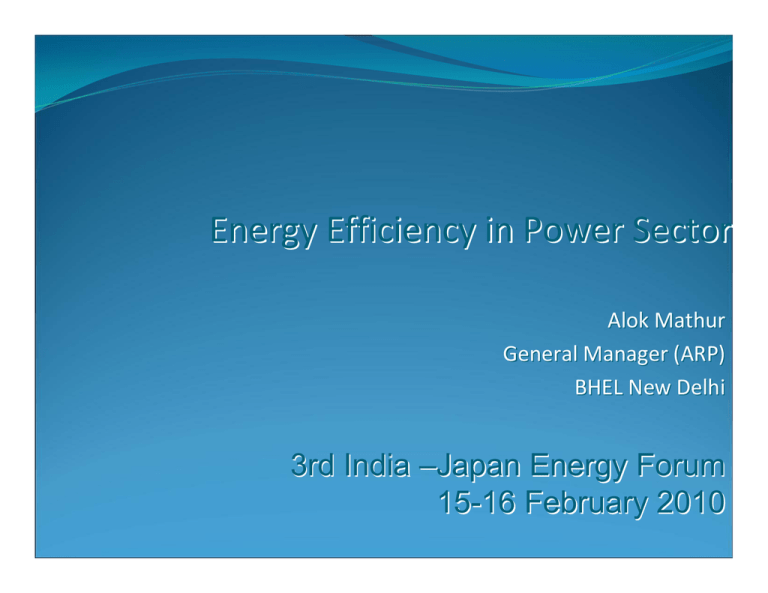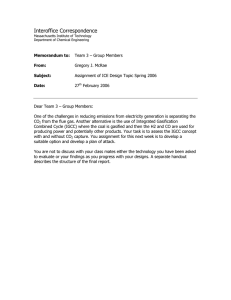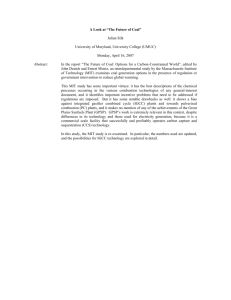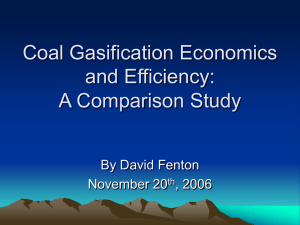Energy Efficiency in Power Sector
advertisement

Energy Efficiency in Power Sector Alok Mathur General Manager (ARP) BHEL New Delhi 3rd India –Japan Energy Forum 15-16 February 2010 Importance of Increasing Efficiency in Power Sector y y y y y Less fuel burnt per unit Less CO2 and other pollutants per unit Conserves non‐renewable fuel Reduces cost of generation Reduces requirement of fresh capacity addition Predominance of Coal • Coal is predominant source of energy for power generation – 40% in world – 70% in India • Coal likely to remain mainstay of India's electricity generation for next twenty five years • With explosive growth in energy demand, the consumption of coal is slated to increase many fold Strategies to Improve Efficiency in Power Sector y Multi‐pronged strategy has to be adopted: y Improvements in existing technologies such as subcritical power plants and hydro power plants y R&M of aged power plants y Introduction of supercritical and ultra supercritical power plants y Introduction of advanced technologies such as Integrated Gasification Combined Cycle (IGCC) y Reduce losses in power transmission Improvements in Steam Turbines • For every 1 kcal/ kWh reduction in TG cycle heat rate, coal consumption per year reduces by – 300 tonnes for 210 MW sets – 700 tonnes for 500 MW sets • Since 1977, heat rate of BHEL’s steam turbines has reduced – 210 MW by 5.4% – 500 MW by 3.1% • Efficiency of steam turbines is being improved by – More efficient aerodynamic blade profiles – Re‐designing inlet and outlet sections – Reduction of primary and secondary heat losses – Effective inter‐stage sealing – Using higher steam parameters especially reheat steam temperature New 500 MW Steam Turbine • New variant of 500 MW steam turbine introduced by BHEL – Reheat steam temperature raised from 537°C to 565°C – Flow paths of HP, IP and LP turbines redesigned – Advanced class blade profiles • Reduction of heat rate by 10 kcal/kWhr • Thermal performance 0.6% better than conventional cycle • New cycle adopted for NTPC Dadri, Simhadri, Ennore, Aravali, etc. New Rating of 600 MW • New unit rating of 600 MW developed – Uses existing HP and IP turbine modules of 500 MW – LP turbine changed from N30‐2 x 10.0 to N30‐4 x 6.3 (two LP turbines of 250 MW) • Two alternatives – 6‐heater cycle and 537 °C reheat temperature – 7‐heater cycle and 565 °C reheat temperature • Lower cost per MW • One percent improvement in heat rate over conventional 500 MW • Saving of 24,000 tonnes of coal per year • First 600 MW plant being installed at North Chennai, with a 7‐ heater cycle Auxiliary Power Consumption • Aerofoil bladed PA fans, with inlet guide vane control in place of damper control, has helped reduce fan losses • Replacement of worm gear by planetary gear in pulverisers has improved energy efficiency. • Efficiency of boiler feed pumps being enhanced by one percent through thermo hydraulic re‐design • Use of variable speed drives with ID fans and BFPs can reduce energy losses at part loads • Use of efficient motors such as H‐compact can increase drive efficiency by 0.6% Control & Instrumentation • Modern distributed control systems help to run all power plant equipment at close to their optimum operating points • PADO (Performance Analysis, Diagnosis and Optimisation) software provides online guidance to run the plant with minimum losses and downtime • Smart wall blowing system can optimise steam blowing cycle for soot blowers – Improving the heat absorption in boiler surfaces – Reducing the consumption of auxiliary steam Supercritical Power Plants • Power plant cycle above critical pressure (221.2 bar) • Offers advantage of ‘burn less fuel for the same output’ and low emissions • Current steam parameters in India: 250 bar, 568 °C main steam and 593 °C hot reheat temperature • Steam parameters are expected to be raised further, in line with global trends • During the 12th Five Year Plan, over 50% of the capacity expansion will be through supercritical power plants Ultra Supercritical Power Plants • Worldwide, Ultra Supercritical (USC) plants with steam parameters up to 280 bar and 620 OC have been set up • Development of USC plants with steam parameters of 300 bar and 700 OC is in progress • The first such plant is expected by 2015 USC Technology in India y India also plans to shift to USC steam parameters over the next few years y India also plans to develop USC technology with 300 bar and 700 OC y The key challenges y Development of suitable materials y Development of an optimum thermodynamic cycle y Development of major equipment such as steam generators, steam turbines and their auxiliaries Integrated Gasification Combined Cycle (IGCC) y Important technology in the context of climate change y Emission of CO2 per MW less than for conventional plants y Potential efficiency (~45%) higher than that of sub‐critical (~37%) and super‐critical (~40%) y Capture of CO2 is easier in the case of IGCC y Low NOx and SOx emissions y Low water consumption y Fuel flexibility: coal as well as refinery residues y Syn Gas can be used for conversion to oil, chemicals, fertiliser and hydrogen IGCC vs. Conventional Coal Plant Conventional Coal Plant IGCC Plant y y y y y y y NOx 350 ppm SOx 600 ppm SPM 50 mg/Nm3 CO2 Emission High CO2 capture ready No Fuel consumption High less Water consumption High <25 ppm <245 ppm <2 mg/Nm3 10% Less Yes 7% 40% Less BHEL’s Experience in IGCC • BHEL has been developing IGCC technology since the early eighties • BHEL has gained a lot of experience in the development and operation of a pilot 6.2 MW IGCC plant at Trichy • BHEL now well poised to set up a 182 MW IGCC Demonstration Project with APGENCO at Vijaywada • Uses Pressurised Fluidised Bed Gasification (PFBG) technology, most suited for Indian coals Milestones in IGCC Development Scale up: Geometrical - 1:1.14 Capacity - 1: 1.21 Pressure - 1:0.9 Scale up: Geometrical - 1: 2.91 Capacity - 1: 11.1 Pressure - 1:3 Scale up: Geometrical - 1: 3.3 Capacity - 1: 9.33 Pressure - 1:1.2 Scale up: Geometrical - 1: 2.25 Capacity - 1: 15 Pressure - 1:5 Dia 0.2 m Press 2.0 ata 1.2 TPD (APFBG) Corp R&D Hyderabad 182 MW IGCC 125 MW IGCC 6.2 MW CCDP 18 TPD (PEDU) Corp. R&D, Hyderabad Tiruchy 450- 650 MW IGCC Concept Design APGENCO Vijaywada Future Commercial Scale IGCC Plant BHEL’s IGCC Development 6.2 Mwe IGCC with moving bed gasifier Process & Equipment Developme nt (PEDU) pilot plant based on PFBG 6.2 Mwe IGCC retrofitted with PFBG Start July 1983 Start May 1986 Start Sep 1993 Commg Mar 1988 Commg May 1988 Commg Jan 1996 Developmental testing Compln Sep 1992 Developmental testing Compln Jan 1997 Extensive testing carried out To gain experience in gasification and IGCC plant operation Design and fabrication of major equipmt and development of PFBG technology Data for scale-up of gasifier and its integration with CC 6.2 MW IGCC Pilot Plant at Trichy 6.2 MW IGCC Pilot Plant at Trichy 182 MW IGCC Project y Rating 182 MW y Gasifier – 2265 tpd coal capacity using Pressurised Fluidised Bed Gasification (PFBG) technology y Gasifier Pressure: 28 kg/cm2, Temperature: 1025 °C y Ash content: 36‐42% (Ash up to 50% can be accepted) y Gas clean‐up system including barrier filters and wet scrubbers y Frame 9E Gas Turbine: 102 MW y Heat Recovery Steam Generator (Two pressure) y Steam turbine: 80 MW y Gross efficiency: >40% y Coal & ash handling system y Switchyard Future Directions in IGCC y y y y y y y y y 450‐650 MW capacity commercial plant Advanced class gas turbine Oxygen enriched gasification Low cost oxygen separation technology Hot gas clean‐up technology Greater degree of integration CO2 capture Hydrogen firing in gas turbines Integration with fuel cells Power Transmission • Flexible AC Transmission Systems (FACTS), have been developed and introduced • Can be used in transmission networks to reduce system losses • Thyristor Controlled Series Compensation (TCSC) systems enable increased power flow in existing lines • Controlled Shunt Reactor (CSR) developed to replace “fixed” shunt reactors • Fixed shunt reactors cause continuous power losses • CSR comes into the circuit only when required • Installed 50 MVAR CSR in PGCIL sub‐station at Itarsi in 2001 • Excellent operational feedback • MAHAGENCO has placed orders for two sets of CSRs for different locations HVDC • High Voltage Direct Current (HVDC) is also employed to reduce transmission losses in long distance power flow. • Advantages: lower losses, complete control of power flow on the HVDC line, reduced requirement of right of way, etc. • HVDC can also be used to interconnect electrical grids operating at different frequencies – Surplus power from one region can be transmitted to a power deficit region – More efficient and effective utilization of resources Conclusion y India is poised to expand its power sector in a big way y New technologies are being introduced to enhance energy efficiency y International cooperation would be greatly welcome in these areas






